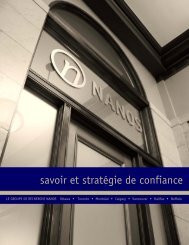Future of the Gardiner Expressway - Nanos Research
Future of the Gardiner Expressway - Nanos Research
Future of the Gardiner Expressway - Nanos Research
You also want an ePaper? Increase the reach of your titles
YUMPU automatically turns print PDFs into web optimized ePapers that Google loves.
Urban Design Goals Open Space Goals Transportation Goals Economic Dev. Goals– – – –• Increase pedestrian access to <strong>the</strong>waterfront.• Preserve and enhance views <strong>of</strong> waterfrontand mountains.• No significant open space goalsbeyond enhancing waterfrontaccess.• Replace elevated structure with deepbored tunnel and six-lane at-gradeboulevard.• Provide new light rail along Viaductroute.• Public dialogue about alternativesconsidered whe<strong>the</strong>r future scenarioshould accommodate current trafficvolumes or encourage mode-shift.• Increase downtown and waterfrontproperty values.• Grow tourism through new waterfrontamenities.• Most waterfront land is privatelyowned,so limited opportunity for Cityto recapture $4.24 billion publicinvestment in <strong>the</strong> bored tunnel.• Enhance pedestrian connections towaterfront.• Boulevard design coordinated withplans and design guidelines forHudson River Park and ManhattanGreenway.• Demolish elevated highway andreplace with six-lane at-gradeboulevard.• Limit access in order to reducecongestion on neighborhood streets,but enhance role as collectordistributionroad.• Whereas Westway was intendedto create long-term developmentopportunities on filled land, <strong>the</strong> WestSide Highway created demand foradaptive reuse and infill.• Reclaim 4.5 acres <strong>of</strong> developmentparcels for residential and <strong>of</strong>fice.• Enhance value <strong>of</strong> redevelopment in CiteMultimedia and Griffintown.• Create new entrance to <strong>the</strong> city.• Develop new retail under railroad viaduct.• Provide access to Peel Basin,waterfront park network, andwaterfront amenities.• Demolish elevated expressway andexpand two at-grade boulevards.• New light rail to reduce automobiledemand.• Create new underground pedestriannetwork with connections to transitstations.• Develop 12,500 new housing units.• Develop 900,000 square meters <strong>of</strong>commercial, and 1 million squaremeters <strong>of</strong> cultural and recreation space.• Integrate downtown street grid with newurban boulevard, <strong>the</strong>reby creating newdevelopment parcels.• Connect downtown cultural amenities to<strong>the</strong> waterfront.• New and reconstructed waterfrontpark, amenities, and amphi<strong>the</strong>ater.• New pedestrian connectionsacross Tennessee River.• Replace grade-separated parkway withat-grade boulevard.• Reduce excess road capacity to meetexisting demand.• Create a framework for newdevelopment downtown and on <strong>the</strong>Tennessee River’s north shore.• 21st Century Waterfront is estimated tohave attracted US $2 billion in privateinvestment.• Complement new urban boulevard withwaterfront esplanade, public art, and newretail and housing development.• Reconnect downtown San Francisco to<strong>the</strong> bay.• Restoration <strong>of</strong> <strong>the</strong> historic Ferry Buildingas a regional food market.• New waterfront esplanade andpedestrian and bicycle greenway.• Replace earthquake-damaged elevatedhighway with six-lane at-grade urbanboulevard.• Advance city’s “transit first” policiesby providing new waterfront streetcarroute.• Reclaim 100 acres for new housing,<strong>of</strong>fice, and public space.• Encourage development <strong>of</strong> over10,000 new housing units in adjacentneighborhoods.• Advance Mayor’s commitment tomaking Seoul a model for sustainabledevelopment.• Reverse property value and populationdecline in commercial and retail districtsfacing Cheonggyecheon <strong>Expressway</strong>.• Create new open space amenityfor entire city.• Day-light historic creek and createwaterfront esplanade.• Replace four-lane elevated expresswayand ten-lane at-grade highway withtwo two-lane boulevards.• Create new bus rapid transit serviceon Cheonggyecheon route.• Reduce traffic demand throughincentives for commuters to usetransit and increasing user fees.• Streng<strong>the</strong>n Seoul’s position as a globalfinancial center.• Government reported cost at US $390million, though may have been as highas US $900 million.•• Reclaim land for housing and waterfrontopen space.• Improve access to Hunts Point Market(wholesale food distribution center).• Connect to planned Bronx Riverwatershed greenway.• The purpose <strong>of</strong> <strong>the</strong> study was toimprove truck circulation into HuntsPoint Market. A community planproposed removing <strong>the</strong> highway. While<strong>the</strong> NYSDOT included this optionin <strong>the</strong>ir study, it was ultimately notselected.• Provide 1,200 affordable housing unitsand 700 jobs.• Enhance upland neighborhood propertyvalues by improving waterfrontconnections.SECTION VII: SUMMARY MATRIX 59



